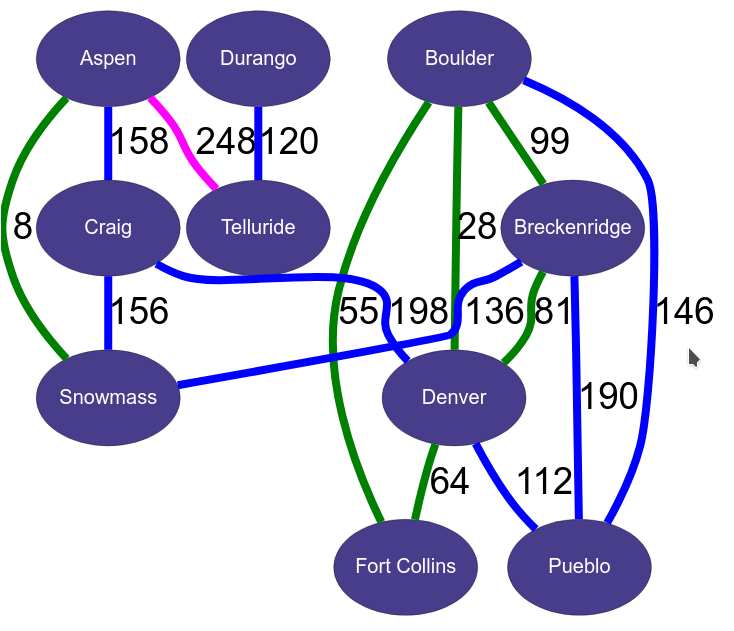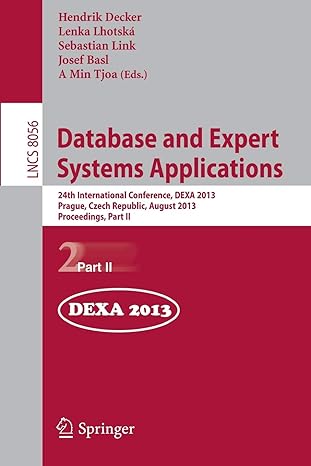Question
fix the readFileMethod / BreadthFirst / DepthFirst Testing Enter an input mileages file and an output graph file in your run configurations, such as below:
fix the readFileMethod / BreadthFirst / DepthFirst
Testing
Enter an input mileages file and an output graph file in your run configurations, such as below:
MileagesSmall.csv
,Aspen,Boulder,Breckenridge,Craig,Denver,Durango,Fort Collins,Pueblo,Snowmass,Telluride
Aspen,,,,158,,,,,8,248
Boulder,,,99,,28,,55,146,,
Breckenridge,,,,,81,,,190,136,
Craig,,,,,198,,,,156,
Denver,,,,,,,64,112,,
Durango,,,,,,,,,,120
Fort Collins,,,,,,,,,,
Pueblo,,,,,,,,,,
Snowmass,,,,,,,,,,
Telluride,,,,,,,,,,
resources/MileagesSmall.csv MileageSmall.dot
Here is the output you should see from your program, when it is working correctly:
digraph BST { ratio = 1.0; node [style=filled] node [fillcolor=darkslateblue] node [fixedsize=true] node [shape=oval] node [width=6] node [height=4] node [fontname=Arial] node [fontsize=60] node [fontcolor=white] edge [dir=none] edge [penwidth=24] edge [fontname=Arial] edge [fontsize=110] Node0 [label="Aspen"]; Node1 [label="Boulder"]; Node2 [label="Breckenridge"]; Node3 [label="Craig"]; Node4 [label="Denver"]; Node5 [label="Durango"]; Node6 [label="Fort Collins"]; Node7 [label="Pueblo"]; Node8 [label="Snowmass"]; Node9 [label="Telluride"]; Node0 -> Node8 [label="8" color="green"] Node1 -> Node4 [label="28" color="green"] Node1 -> Node6 [label="55" color="green"] Node4 -> Node6 [label="64" color="green"] Node2 -> Node4 [label="81" color="green"] Node1 -> Node2 [label="99" color="green"] Node4 -> Node7 [label="112" color="blue"] Node5 -> Node9 [label="120" color="blue"] Node2 -> Node8 [label="136" color="blue"] Node1 -> Node7 [label="146" color="blue"] Node3 -> Node8 [label="156" color="blue"] Node0 -> Node3 [label="158" color="blue"] Node2 -> Node7 [label="190" color="blue"] Node3 -> Node4 [label="198" color="blue"] Node0 -> Node9 [label="248" color="magenta"] } And this is the image that it generates:

In recitation you were exposed to webgraphviz as a visualization tool. Another way to generate the png is via the terminal with using the following command:
$ cd path/to/MileageSmall.dot $ dot -Tpng MileageSmall.dot > MileageSmall.png
// GraphImplementation.java - supplied code for graph assignment
import java.io.File;
import java.io.IOException;
import java.io.PrintWriter;
import java.util.*;
public class GraphImplementation extends GraphAbstract {
// Main entry point
public static void main(String[] args) {
if (args.length != 2) {
System.err.println("usage: java GraphImplementation ");
System.exit(-1);
}
// Instantiate code
GraphImplementation impl = new GraphImplementation();
// Read distances chart
System.out.println("Reading Chart: " + args[0]);
impl.readGraph(args[0]);
System.out.println();
// Write distances graph
System.out.println("Writing Graph: " + args[1]);
impl.writeGraph(args[1]);
System.out.println();
// Print depth first search
System.out.println("Depth First Search:");
impl.depthFirst("Fort Collins");
System.out.println();
// Print breadth first search
System.out.println("Breadth First Search:");
impl.breadthFirst("Aspen");
System.out.println();
/*
// EXTRA CREDIT: Print all shortest paths
for (int from = 0; from
for (int to = 0; to
if (from != to) {
String fromCity = cities.get(from).name;
String toCity = cities.get(to).name;
System.out.print("Shortest Path: ");
impl.shortestPath(fromCity, toCity);
}
}
*/
}
// Reads mileage chart from CSV file
public void readGraph(String filename) {
// YOUR CODE HERE
ArrayList myCities = readFile(filename);
String[] line1 = myCities.get(0).split(",");
for(int i = 1; i
cities.add(new GraphNode(line1[i]));
}
for(int j = 1; j
String[] edgeLine = myCities.get(j).split(",");
for(int i = 1; i
if(!edgeLine[i].isEmpty()) {
mileages.add(new GraphEdge(j-1, i-1, Integer.parseInt(edgeLine[i])));
}
}
Collections.sort(mileages);
}
}
public void writeGraph(String filename) {
ArrayList output = new ArrayList();
output.add("digraph BST {");
output.add(" ratio = 1.0;");
output.add(" node [style=filled]");
output.add(" node [fillcolor=darkslateblue]");
output.add(" node [fixedsize=true]");
output.add(" node [shape=oval]");
output.add(" node [width=6]");
output.add(" node [height=4]");
output.add(" node [fontname=Arial]");
output.add(" node [fontsize=60]");
output.add(" node [fontcolor=white]");
output.add(" edge [dir=none]");
output.add(" edge [penwidth=24]");
output.add(" edge [fontname=Arial]");
output.add(" edge [fontsize=110]");
int cityIndex = 0;
for (GraphNode city: cities) {
output.add(" Node" + cityIndex + " [label=\"" + city.name + "\"];");
cityIndex++;
}
for (GraphEdge edge: mileages) {
if (!(edge.fromIndex >= edge.toIndex)) {
String color;
if (edge.mileage 100) {
color = "green";
}
else if (edge.mileage 200) {
color = "blue";
}
else if (edge.mileage 300) {
color = "magenta";
}
else {
color = "red";
}
output.add(" Node" + edge.fromIndex + " -> Node" + edge.toIndex + " [label=\"" + edge.mileage + "\" color=\"" + color + "\"]");
}
}
// Write distances graph
output.add("}");
writeFile(filename, output);
}
public void depthFirst(String startCity) {
// YOUR CODE HERE
}
// Recursive helper method
public void depthFirst(int index, ArrayList visited) {
// YOUR CODE HERE
}
public void breadthFirst(String startCity) {
// YOUR CODE HERE
}
public void shortestPath(String fromCity, String toCity) {
// YOUR CODE HERE
}
// Helper functions
/**
* Reads the contents of file to {@code ArrayList}
* @param filename the file to read from
* @return an ArrayList of the contents
*/
static ArrayList readFile(String filename) {
ArrayList contents = new ArrayList();
try(Scanner reader = new Scanner(new File(filename))) {
while (reader.hasNextLine()) {
String line = reader.nextLine().trim();
if (!line.isEmpty())
contents.add(line);
}
} catch (IOException e) {
System.err.println("Cannot read chart: " + filename);
}
return contents;
}
/**
* Write contents of {@code ArrayList} to file
* @param filename the name of the file to write to
* @param contents an ArrayList of contents to write
*/
static void writeFile(String filename, ArrayList contents) {
try(PrintWriter writer = new PrintWriter(filename)) {
for (String line : contents)
writer.println(line);
} catch (IOException e) {
System.err.println("Cannot write graph: " + filename);
}
}
}
----------------------------------------------------------------------------
// GraphAbstract.java - abstract class for graph assignment
import java.util.ArrayList;
public abstract class GraphAbstract {
// Represents a graph edge public class GraphEdge implements Comparable
// Represents a graph node (and incident edges) public class GraphNode { public String name; // City name public ArrayList
/** * Reads mileage chart from CSV file and builds lists of nodes (cities) and edges (distances). *
* The first line contains all the cities which should be represented as {@link GraphNode}s * The successive lines start with a city, followed by a list of mileages to other cities. *
* To avoid redundancy, not all the values are filled in, ignore empty entries. * When you read a mileage, for example from Fort Collins to Pueblo, create only one * entry in the mileages array, but add the edge to both cities. *
* First extract all the edges, then sort the edges by mileage, then add the edges * associated with each node. * @param filename the CSV file */ public abstract void readGraph(String filename);
/** * Writes mileage graph to DOT file. *
* Traverses the data structures created above and writes nodes and edges in GraphViz format. * You will build the GraphViz format into an {@code ArrayList}, which will then be written to file * using the {@link GraphImplementation#writeFile(String, ArrayList)} method. *
* Use the provided example and the following directions to implement this method: *
- *
- All attributes of nodes and edges that are identical are put into the header of the .dot file. *
- The nodes are labeled Node0, Node1, etc., in the same order as the input file, * and they have city names as labels. *
- The edges are then written, in the format Node0 -> Node1, etc. and labeled with a distance and color. *
* HINT: Match the file format exactly as provided in order to pass automated grading! * @param filename the output file name */ public abstract void writeGraph(String filename); // Print graph in depth first search order public abstract void depthFirst(String startCity);
// Print graph in breadth first search order public abstract void breadthFirst(String startCity);
// Calculate and print shortest path public abstract void shortestPath(String fromCity, String toCity); }
Aspen Durango Boulder 158 248120 8 Craig 28 Breckenridge Telluride 156 55198 13681 146 190 Snowmass Denver 64 112 Fort Collins PuebloStep by Step Solution
There are 3 Steps involved in it
Step: 1

Get Instant Access to Expert-Tailored Solutions
See step-by-step solutions with expert insights and AI powered tools for academic success
Step: 2

Step: 3

Ace Your Homework with AI
Get the answers you need in no time with our AI-driven, step-by-step assistance
Get Started


